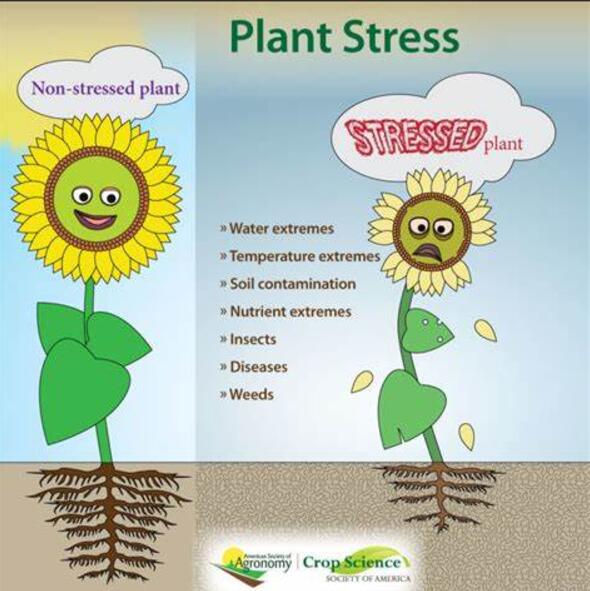Modulating reactive oxygen species and ion homeostasis for combined salt and cadmium stress tolerance in Brassica campestris: The role of beneficial microbes
IF 6.8
Q1 PLANT SCIENCES
引用次数: 0
Abstract
The land areas and crop species adversely impacted by salinity and heavy metals are growing rapidly. Current research indicates that plant growth-promoting microorganisms offer an environmentally friendly option for improving physiological and biochemical processes in plants growing under stress conditions. The aim of the present study was to investigate the potential mitigation of simultaneous salinity and cadmium (Cd) stress in rapeseed (Brassica campestris cv. BARI Sarisha-17) by the application of Azospirillum sp. (Az), phosphate solubilizing bacteria (PSB), potassium mobilizing bacteria (KMB), and vesicular arbuscular mycorrhiza (VAM). Seeds were treated with PSB or KMB prior to sowing, whereas Az, PSB, KMB, or VAM were added as supplements during soil preparation. At 21 days after sowing, the plants were treated with a combination of salt (100 mM NaCl) and Cd (0.25 mM CdCl2), with several applications at 7-day intervals. The combination of salt and Cd stress decreased plant growth and biomass, relative water content, and photosynthetic pigment levels, while also increased electrolyte leakage, lipid peroxidation, and the generation of excess reactive oxygen species (ROS). Salt and Cd stress also impaired plant ion balances of sodium, potassium and nitrate, antioxidant defenses, and glyoxalase system activity. Application of Az, PSB, or KMB restored these parameters to unstressed levels by facilitating the scavenging of ROS, maintaining water status, restoring ion balances, enhancing plant antioxidant defenses, and increasing glyoxalase enzyme activity, while reducing methylglyoxal toxicity and improving photosynthetic activity. The application of KMB was the most effective; however, all microbe supplementations showed the ability to alleviate the damage caused by stress in rapeseed. These findings highlight the ability of soil microorganisms with plant growth-promoting properties to improve the physiological and biochemical functions of rapeseed under Cd and salt stress.
调节活性氧和离子平衡以提高甘蓝菜对盐和镉胁迫的综合耐受性:有益微生物的作用
受盐度和重金属不利影响的土地面积和作物种类正在迅速增加。目前的研究表明,植物生长促进微生物为改善胁迫条件下植物的生理和生化过程提供了一种环境友好型选择。本研究旨在通过施用 Azospirillum sp. (Az)、磷酸盐溶解菌 (PSB)、钾调动菌 (KMB) 和泡状节肢菌根 (VAM),探讨减轻油菜籽(Brassica campestris cv. BARI Sarisha-17)同时受到盐度和镉(Cd)胁迫的可能性。播种前用 PSB 或 KMB 对种子进行处理,而 Az、PSB、KMB 或 VAM 则作为补充剂在土壤制备过程中添加。播种后 21 天,用盐(100 mM NaCl)和镉(0.25 mM CdCl2)组合处理植物,每隔 7 天施用几次。盐和镉的综合胁迫降低了植物的生长和生物量、相对含水量和光合色素水平,同时还增加了电解质渗漏、脂质过氧化和过量活性氧(ROS)的产生。盐胁迫和镉胁迫还损害了植物钠、钾和硝酸盐的离子平衡、抗氧化防御能力和乙二醛酶系统的活性。施用 Az、PSB 或 KMB 能促进清除 ROS、维持水分状态、恢复离子平衡、增强植物抗氧化防御能力和提高乙醛酸酶活性,同时降低甲基乙二酸毒性和提高光合作用活性,从而将这些参数恢复到非胁迫水平。施用 KMB 的效果最好,但所有微生物补充剂都能减轻胁迫对油菜籽造成的损害。这些发现凸显了具有促进植物生长特性的土壤微生物在镉和盐胁迫下改善油菜生理生化功能的能力。
本文章由计算机程序翻译,如有差异,请以英文原文为准。
求助全文
约1分钟内获得全文
求助全文
来源期刊

Plant Stress
PLANT SCIENCES-
CiteScore
5.20
自引率
8.00%
发文量
76
审稿时长
63 days
期刊介绍:
The journal Plant Stress deals with plant (or other photoautotrophs, such as algae, cyanobacteria and lichens) responses to abiotic and biotic stress factors that can result in limited growth and productivity. Such responses can be analyzed and described at a physiological, biochemical and molecular level. Experimental approaches/technologies aiming to improve growth and productivity with a potential for downstream validation under stress conditions will also be considered. Both fundamental and applied research manuscripts are welcome, provided that clear mechanistic hypotheses are made and descriptive approaches are avoided. In addition, high-quality review articles will also be considered, provided they follow a critical approach and stimulate thought for future research avenues.
Plant Stress welcomes high-quality manuscripts related (but not limited) to interactions between plants and:
Lack of water (drought) and excess (flooding),
Salinity stress,
Elevated temperature and/or low temperature (chilling and freezing),
Hypoxia and/or anoxia,
Mineral nutrient excess and/or deficiency,
Heavy metals and/or metalloids,
Plant priming (chemical, biological, physiological, nanomaterial, biostimulant) approaches for improved stress protection,
Viral, phytoplasma, bacterial and fungal plant-pathogen interactions.
The journal welcomes basic and applied research articles, as well as review articles and short communications. All submitted manuscripts will be subject to a thorough peer-reviewing process.
 求助内容:
求助内容: 应助结果提醒方式:
应助结果提醒方式:


